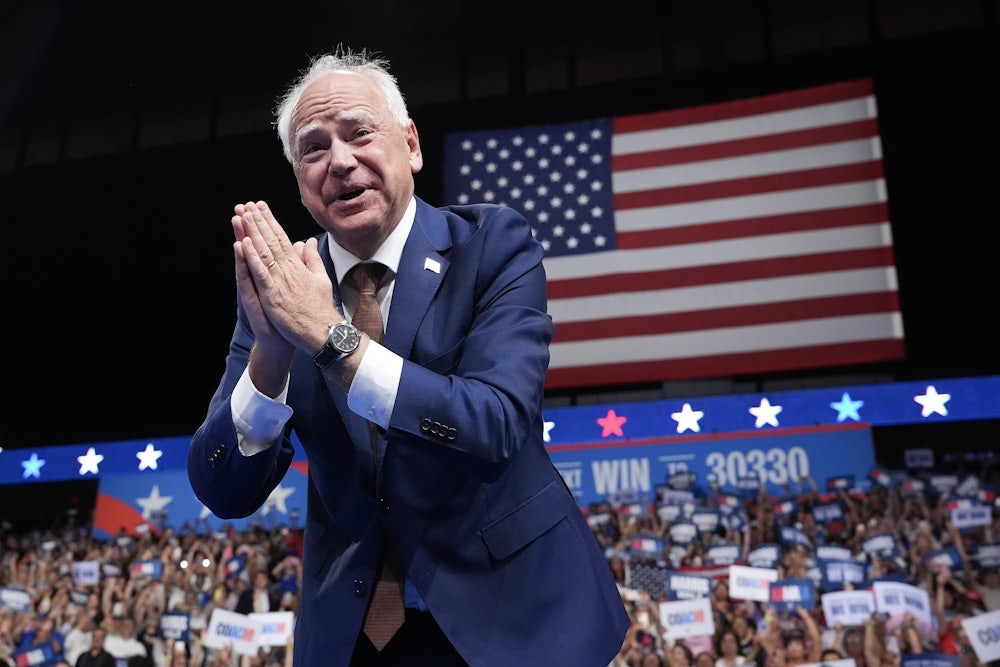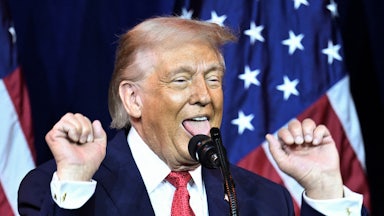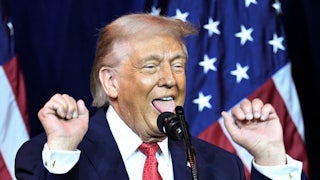Tim Walz is a moderate who seeks common ground. No, wait: He’s a radical, left-wing socialist.
Since Vice President Kamala Harris chose the Minnesota governor as her running mate, politicians and many voters have struggled to pin down Walz’s ideology. Democrats prefer to see him as a folksy “prairie populist” who represented a congressional district won twice by Donald Trump; meanwhile, Trump calls Walz a “freakish” Communist “comrade” beloved by “pink-haired Marxists.” Even the even-keeled Larry Hogan, the popular two-term Republican governor running for U.S. Senate in deeply blue Maryland, struggled when asked to described Walz: “He’s not a centrist,” said Hogan, adding that he “wouldn’t label him a radical” either.
While a great deal of attention has been paid to the way Walz’s biography and persona—his rural upbringing, work as a football coach, and corny but endearing Midwestern-dad vibes—cut against stereotypes of Democratic officeholders, he offers an equally fruitful opportunity for his party to shift the electorate’s understanding of ideology itself. The oversimplified left-right continuum we usually deploy to categorize politicians doesn’t capture who Walz is and what he has done as governor. His brand of politics is better understood along a “me/we” continuum—that is, from libertarian to communitarian. And he sits decidedly on the latter pole.
Before we explain why Walz’s communitarian tendencies are easily overlooked and misconstrued, let’s first unpack a pair of problematic narratives about him produced by the left-right frame.
The first is that Walz is an ideological convert who replaced his early-career policy centrism with more liberal positions on issues such as government spending, race relations, public education, and identity politics. As a congressman representing a rural swing district, he was more moderate, but then he made a left turn upon becoming governor, especially after his party took narrow control of the state legislature in 2022. With that control in hand (including a one-vote majority in the state Senate), he signed a slew of progressive laws.
The second narrative asserts a disconnect between Walz’s personal affect and his policy agenda. His liberalism, this story goes, is cloaked by his biography and pictures that evoke small-town Midwesternness: in his National Guard uniform, on the football field, wearing a barn jacket and camo cap, hugging a piglet. Such imagery evokes a mild-mannered moderation and down-the-middle normalcy that mask what conservative critics say is Walz’s radical congressional voting record and gubernatorial agenda.
To be fair, there’s some truth to each narrative, but both largely miss the mark. Consider the program Walz enacted that guarantees that every child in Minnesota’s public school system enjoys a free breakfast and lunch. Given the widely shared photos of Walz being swarmed by schoolkids at the event where he signed the bill into law, this policy is perhaps—both literally and figuratively—the signature achievement of his governorship.
Yet to MAGA Republicans, this program epitomizes inefficient, big-government liberalism. So reactionary are many GOP governors, in fact, that more than a dozen of them have refused to accept free federal money to provide lunches to poor kids during summertime when schools are out of session. Why let hunger and the chance to recoup taxes sent to Washington by your state’s residents get in the way of anti-government pique?
The pragmatic argument for free school lunches is both straightforward and compelling: Providing all kids with free meals improves their health and performance in school, eliminates the stigma of “lunch debt,” and relieves schools of the administrative burden of verifying parents’ incomes and processing payments. Coupled with a companion law Walz signed that provides free tuition to Minnesota college students from families with incomes below $80,000, these investments yield better-educated students who in turn are more likely to become productive, law-abiding, tax-paying citizens who make the state’s workforce more competitive and expand the statewide tax base.
These investments are driven by a simple communitarian ethic, one that many Republicans find deeply unsettling. To the accusation that Democrats are dangerous socialists, Walz has responded that “one person’s socialism is another person’s neighborliness,” which connects policy questions affecting large populations to the ground level of communities where people care about each other’s well-being. Conservatives may point to that as proof of a sinister agenda, but in doing so they draw more attention to Walz’s “Minnesota nice” affect and policy choices.
That’s not to say there are no individualistic notes in Walz’s rhetoric; he does say, when talking about abortion rights, that “in Minnesota, we respect our neighbors and their personal choices that they make. Even if we wouldn’t make the same choice for ourselves, there’s a golden rule: Mind your own damn business.” But that frames the issue as one of mutual respect, grounded in the sometimes delicate necessities of maintaining a peaceable community. In contrast, Trump and his running mate, J.D. Vance, are much more likely to portray every aspect of national life as a zero-sum conflict with winners and losers, where the highest aspiration, in Trump’s words, is “so much winning.”
Liberal politics in Minnesota has always stressed mutuality of interests; the Democratic Party there is officially called the Democratic-Farmer-Labor Party, born of a 1944 merger of the Democrats and the Farmer-Labor Party. And it’s no accident that Walz got his start in politics by attending a training by Wellstone Action, the organization run by acolytes of the late Senator Paul Wellstone. Wellstone was a figure of the left, but he also insisted that almost anyone could be won to the cause of progressivism if you knocked on their door, spoke to them as one human being to another, and found the places where you shared similar goals.
On the other side, we have perhaps the most selfish and narcissistic figure in the history of American politics, joined with a running mate who sits in the Senate because libertarian tech mogul Peter Thiel spent $15 million to put him there. Both see government as an instrument to get yours—in Trump’s case, to serve his own personal interests and take revenge on his enemies, and in Vance’s case, to impose a reactionary conservative regime that will crush the left once and for all. (Conservatives are “going to have to get pretty wild” when they seize the reins of power, he has said.) If those are your goals, then mutually beneficial policy aims—whether feeding kids or rebuilding infrastructure—are almost beside the point.
For now, Republicans have decided to attack both Harris and Walz using a strategy that dates back decades but hasn’t really worked since it was used to defeat John Kerry in 2004. In election after election, the GOP charged that Democratic nominees were “dangerously liberal,” full of disturbing and alien ideas that would bring us to ruin. Which is exactly what they’re saying now. “Walz is obsessed with spreading California’s dangerously liberal agenda far and wide,” said a Trump campaign spokesperson.
Yet Harris’s pick was praised by figures across the Democratic spectrum, from Alexandria Ocasio-Cortez to Joe Manchin (who seldom bypasses an opportunity to bash his now-former party as too liberal). That doesn’t mean Tim Walz has managed to fool anyone about his true ideology; it may suggest instead that his most fundamental political value is that we’re all in it together. So far, the argument seems to be gaining traction.






